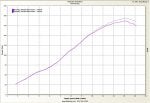I have a question for any members who know more than me. (basically everyone. :dontknow A clerk behind the counter at a local helmet store (who says he used to tune bikes) told me that by reducing the rotating mass on a bike by putting on lighter wheels, that you will boost horsepower. I dont think this sounds right. Maybe, by reducing weight and thereby going faster, you might feel like you have more power. I know that when you replace the rear sprocket with a larger one, you accelerate faster but there is not an increase in hp.
A clerk behind the counter at a local helmet store (who says he used to tune bikes) told me that by reducing the rotating mass on a bike by putting on lighter wheels, that you will boost horsepower. I dont think this sounds right. Maybe, by reducing weight and thereby going faster, you might feel like you have more power. I know that when you replace the rear sprocket with a larger one, you accelerate faster but there is not an increase in hp.
Any way, I just want to know for the sake of knowing, so thanks in advance to anyone who takes a minute to answer this for me.
Any way, I just want to know for the sake of knowing, so thanks in advance to anyone who takes a minute to answer this for me.





